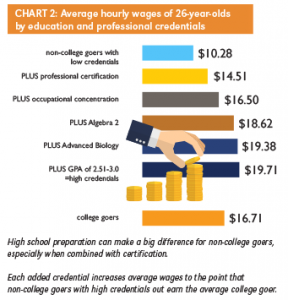 The Center for Public Education has analyzed the National Center for Education Statistics’ Education Longitudinal Study to look at a student group that is often ignored in major research studies – the one in five students who do not immediately enroll in college after graduating from high school. Be sure to check out the first installment of this research series, which looked at the characteristics of this group.
The Center for Public Education has analyzed the National Center for Education Statistics’ Education Longitudinal Study to look at a student group that is often ignored in major research studies – the one in five students who do not immediately enroll in college after graduating from high school. Be sure to check out the first installment of this research series, which looked at the characteristics of this group.
Now, CPE has released its second installment – this time attempting to gain insight into “career readiness†for high school graduates by looking at various job-related and social outcomes of this same group of non-college goers by the time they reached age 26. In fact, the data showed that “credentials†and being well prepared in high school matter, particularly for non-college goers who:
- Completed Algebra 2 as highest math course and Advanced biology as highest science;
- Earned a cumulative GPA between 2.51 and 3;
- Completed an occupational concentration in high school (three or more CTE courses in a specific area); and
- Earned a professional certification or license.
Specifically, researchers found that advanced courses, such as Algebra 2 and advanced biology, and an CTE focus can have an impact on non-college going students’ likelihood to have a good job and engage in society. If those same students earn a professional credential, then the scale shifts in favor of the non-college goer, meaning they are actually more likely to be employed, earn good wages and vote than their peers who attended college. Further, better preparation also had a greater impact on black graduates than their white and Hispanic peers, showing that higher credentials can be the key to closing the employment and wage gap.
Rising to the Challenge?
A new survey from Achieve asked college faculty and employers who teach or hire recent high school graduates about their preparedness for college and careers. This is the second release of Achieve’s Rising to the Challenge survey. The first release, from late 2014, examined recent high school graduates’ views on their own preparedness. The full survey is an update to a similar survey Achieve conducted in 2004.
The results reveal many parallels to the students’ own responses – in short, that there is a pervasive opinion that public high schools are not doing enough to prepare students for the expectations they will face in college and the workplace. Contrast those responses with those from the 2004 survey, and the picture becomes even bleaker.
All three groups – college faculty, employers and students – all agreed that to improve preparedness:
- Communicate early in high school about the courses needed for college and careers;
- Provide more opportunities for challenging courses; and
- Offer more chances for real-world learning.
Andrea Zimmermann, State Policy Associate


